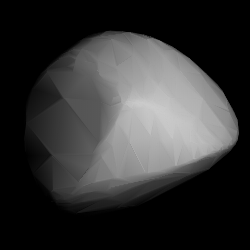
Back 227 Philosophia (كويكب) ARZ 227 Philosophia AST (227) Philosophia Catalan (227) Философия CE (227) Philosophia German 227 Φιλοσοφία Greek 227 Filozofio Esperanto (227) Filosofía Spanish 227 Philosophia Basque فلسفه ۲۲۷ Persian
 3D model based on lightcurve data | |
| Discovery | |
|---|---|
| Discovered by | P.P. Henry |
| Discovery date | 12 August 1882 |
| Designations | |
| (227) Philosophia | |
| Pronunciation | /fɪloʊˈsɒfiə/ |
Named after | Philosophy |
| A882 PA, 1919 AA 1933 SD1, 1949 OO1 | |
| Main belt | |
| Orbital characteristics[1] | |
| Epoch 31 July 2016 (JD 2457600.5) | |
| Uncertainty parameter 0 | |
| Observation arc | 108.20 yr (39519 d) |
| Aphelion | 3.7673 AU (563.58 Gm) |
| Perihelion | 2.56007 AU (382.981 Gm) |
| 3.16366 AU (473.277 Gm) | |
| Eccentricity | 0.19079 |
| 5.63 yr (2055.3 d) | |
Average orbital speed | 16.78 km/s |
| 71.2570° | |
| 0° 10m 30.554s / day | |
| Inclination | 9.1539° |
| 326.254° | |
| 267.020° | |
| Physical characteristics | |
| Dimensions | 87.31±2.4 km |
| 52.98 h (2.208 d) | |
| 0.0768±0.004 | |
| 9.1 | |
227 Philosophia is a large main-belt asteroid that was discovered by the French astronomer Paul-Pierre Henry on August 12, 1882, in Paris and named after the topic of philosophy. Based upon photometric observations, it has a synodic rotation period of 52.98 ± 0.01 with a brightness variation of 0.15 ± 0.02 in magnitude.[2]